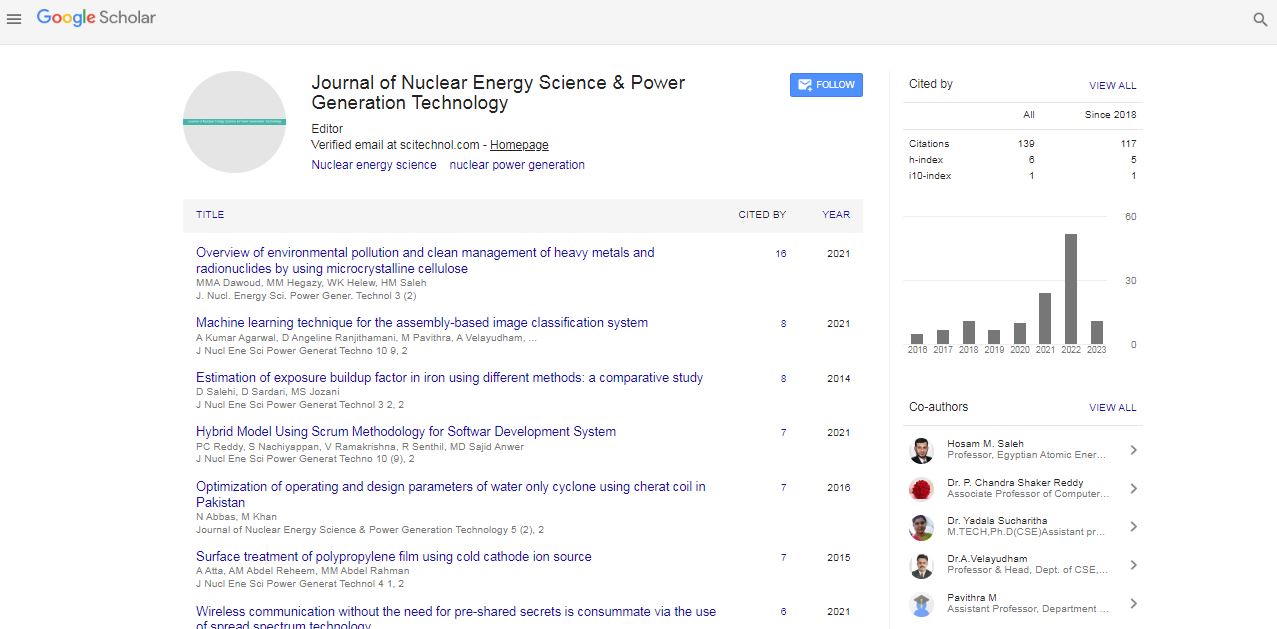Opinion Article, J Nucl Ene Sci Power Generat Technol Vol: 12 Issue: 1
Managing Radioactive Waste: Types, Techniques and Challenges
Hoang Tao*
1Department of Nuclear Physics, VNUHCM-University of Science, Ho Chi Minh City, Vietnam
*Corresponding Author: Hoang Tao
Department of Nuclear Physics, VNUHCMUniversity
of Science, Ho Chi Minh City, Vietnam;
E-mail: hoang.tao@hcmus.edu.vn
Received date: 22-Feb-2023, Manuscript No. JNPGT-23-93186;
Editor assigned date: 24-Feb-2023, PreQC No. JNPGT-23-93186 (PQ);
Reviewed date: 10-Mar-2023, QC No. JNPGT-23-93186;
Revised date: 17-Mar-2023, Manuscript No. JNPGT-23-93186 (R);
Published date: 27-Mar-2023 DOI: 10.4172/2325-9809.1000322.
Citation: Tao H (2023) Managing Radioactive Waste: Types, Techniques and Challenges. J Nucl Ene Sci Power Generat Technol 12:2.
Description
Radioactive waste is a by-product of nuclear power generation, medical procedures, industrial applications, and research activities. It poses a significant threat to human health and the environment if not managed properly. Radioactive waste management involves the collection, transportation, processing, storage, and disposal of radioactive waste. The goal of radioactive waste management is to ensure the safe handling and storage of radioactive waste to prevent exposure to radiation and contamination of the environment.
Types of radioactive waste
Radioactive waste is classified into different categories based on the source and level of radioactivity. The main types of radioactive waste are:
Low-Level Radioactive Waste (LLW): This type of waste contains low levels of radioactivity and is typically generated by medical facilities, research labs, and nuclear power plants. LLW is usually stored in drums or concrete containers and disposed of in shallow land burial sites.
Intermediate-Level Radioactive Waste (ILW): ILW contains higher levels of radioactivity than LLW and is generated by nuclear power plants and some industrial applications. ILW is typically stored in steel containers and disposed of in specialized facilities.
High-Level Radioactive Waste (HLW): HLW contains the highest levels of radioactivity and is generated by nuclear power plants during the production of electricity. HLW is usually stored in specially designed steel and concrete containers and disposed of in deep geological repositories.
Radioactive waste management techniques
There are several techniques used in radioactive waste management, including:
Volume reduction: This technique involves reducing the volume of radioactive waste by compacting or incinerating it. The remaining waste is then stored or disposed of in a specialized facility.]
Chemical treatment: Chemical treatment involves adding chemicals to the radioactive waste to change its physical and chemical properties, making it less hazardous. This technique is used for LLW and some ILW.
Encapsulation: Encapsulation involves encapsulating radioactive waste in a solid material, such as concrete or glass, to prevent its release into the environment. This technique is used for ILW and some HLW.
Storage: Radioactive waste can be stored temporarily in specially designed facilities until it can be transported and disposed of safely. Storage facilities include above-ground facilities, such as dry cask storage, and underground facilities, such as deep geological repositories.
Disposal: Disposal involves placing radioactive waste in a specialized facility designed to isolate it from the environment. Disposal facilities include shallow land burial sites, deep geological repositories, and sub-sea disposal facilities.
Challenges in radioactive waste management
Radioactive waste management presents several challenges, including:
Public perception: There is a significant amount of public concern and fear about the safety of radioactive waste management techniques. This can make it challenging to implement new techniques and facilities.
Cost: Radioactive waste management is expensive, particularly the disposal of HLW. The cost of building and maintaining disposal facilities is high, and there is often significant opposition from local communities.
Regulatory requirements: Radioactive waste management is heavily regulated to ensure the safety of workers, the public, and the environment. Compliance with regulations can be complex and timeconsuming.
Transportation: Transporting radioactive waste from the site of generation to storage or disposal facilities can be challenging. It requires specialized equipment and personnel and must be done safely to prevent accidents or spills.
Long term safety: Radioactive waste remains hazardous for thousands of years, making it challenging to ensure its safe isolation from the environment for such a long period.
Conclusion
Radioactive waste management is a critical process to ensure the safety of workers, the public, and the environment. It involves several techniques, including volume reduction, chemical treatment, encapsulation, storage, and disposal. However, there are significant challenges associated with radioactive waste management.
 Spanish
Spanish  Chinese
Chinese  Russian
Russian  German
German  French
French  Japanese
Japanese  Portuguese
Portuguese  Hindi
Hindi 

